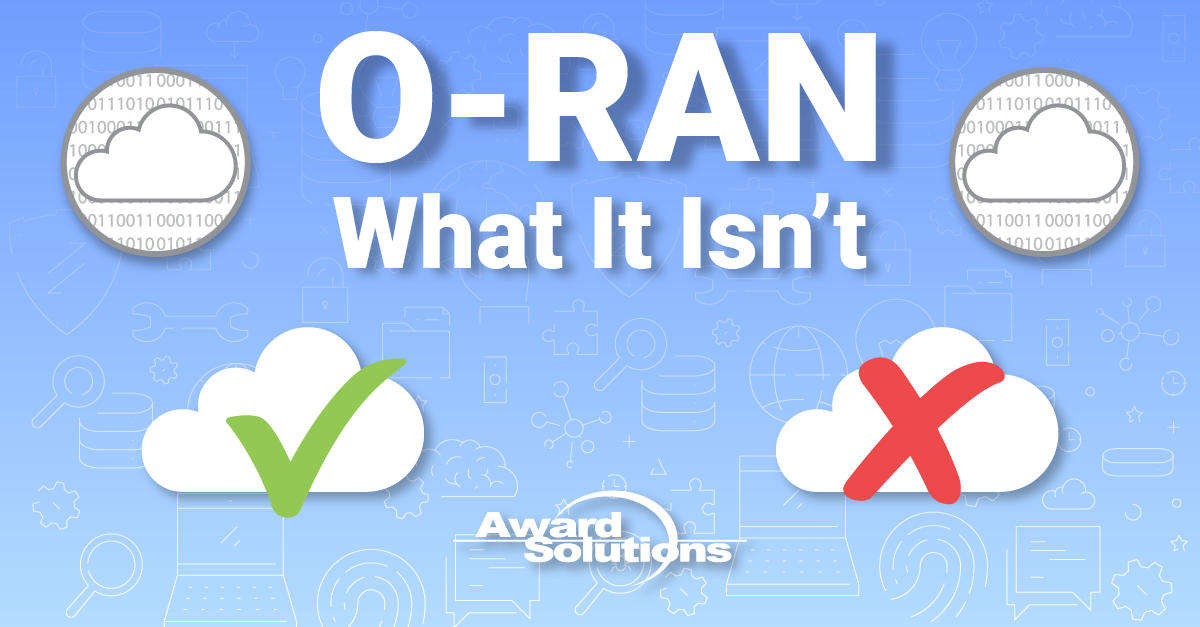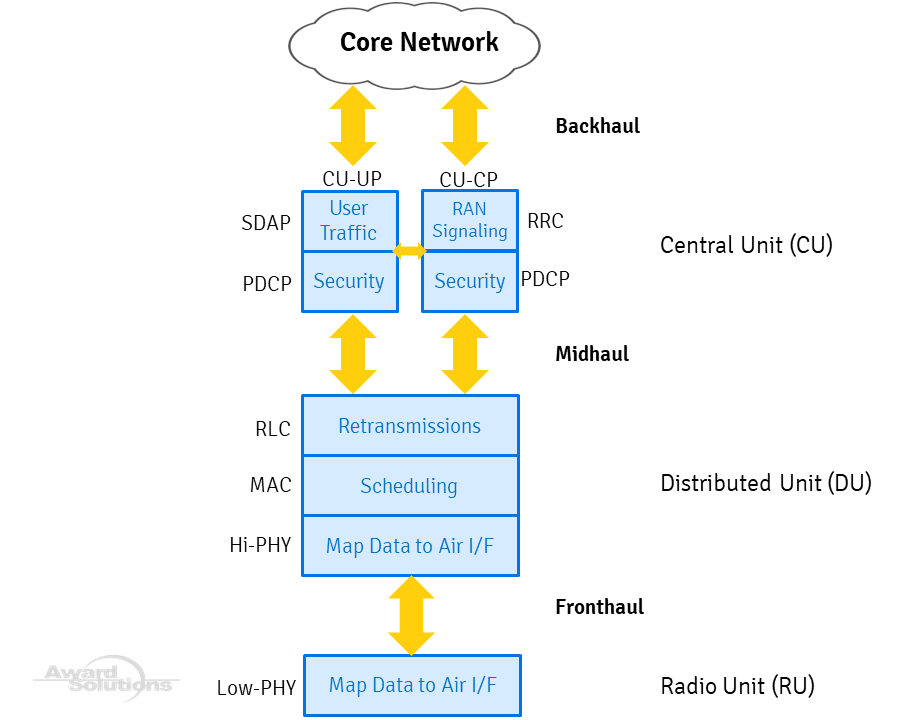
Open RAN (Radio Access Network) is an overloaded term. Broadly, Open RAN can refer to a RAN with open, interoperable interfaces that follow a certain published industry standard. Recently, when people talk about Open RAN, they may also be referring to a RAN that follows the architectural principles (i.e., the functionality and the interface specifications) laid out by the O-RAN Alliance. However, the RAN is undergoing many changes in 5G. They are sometimes complementary and sometimes overlap with the definition of Open RAN (as defined by the O-RAN Alliance). Therefore, we need clarity on the difference between two supporting technologies (Split RAN and Virtual RAN) and Open RAN. Split RAN and Virtual RAN are essential building blocks for Open RAN, but by themselves, they would not qualify as an O-RAN Alliance-defined Open RAN.
What is Split RAN?
In Split RAN, the functionality of a gNodeB (5G base station) separates into three parts: the Radio Unit (RU), the Distributed Unit (DU), and the Central Unit (CU). The figure below shows how the processing of the air interface stack divides among these RAN components.

The RAN processes all the layers of this protocol stack, but the functions of the three RAN elements are split along the layers of the air interface protocol stack. The RU processes the lower part of the Physical Layer, the DU processes the upper part of the PHY, the MAC, and the RLC layers, while the CU processes the PDCP and the RRC (signaling) layers for the control plane, and PDCP and SDAP layers for the user plane.
Lower layers of the protocol stack tend to be more latency-sensitive and throughput-intensive than the upper layers. Splitting the RAN allows the lower layers (RU, DU) to be closer to the air interface, reducing air interface latency and transmission distance and creating the rationale for having a split RAN.
For a more detailed treatment of how the RAN is evolving, please view our Express course on RAN Evolution. A split RAN is a handy building block for an Open RAN, but by itself, a Split RAN is not necessarily an Open RAN.
What is Virtual RAN?
A related concept is that of a Virtual RAN. Historically, all the elements in the RAN were software packaged into custom, purpose-built hardware. The primary reasons why custom hardware (or Application-Specific hardware) was required were stringent performance requirements such as latency and throughput. Achieving this performance required custom silicon. However, custom silicon made it hard to reap economies of scale, led to longer and more expensive upgrade cycles, and ultimately led to a monolithic, single-vendor RAN. Virtualizing the RAN means that the hardware used is Common-Off-The-Shelf (COTS) hardware, and the RAN functionality is implemented as software (using Containers and/or deployed in Virtual Machines). COTS hardware became possible due to relatively recent advances in computing and networking technology – e.g., increased CPU speeds, hyperthreading, NUMA and CPU pinning, Field Programmable Gate Array cards, and GPUs for computing, and technologies such as DPDK and SR-IOV for efficiently processing network traffic. In addition, managing these network functions as software made it possible to automate the management of these functions using orchestration.
For a more detailed treatment of Virtual RAN, please see our course VRAN/Open_RAN Overview. While Virtual RAN is a big step forward, it is also not Open RAN!
What is Open RAN?
OK, so what is Open RAN? Getting away from the more generic view, the O-RAN Alliance, the body that creates specifications for Open RAN, states that its mission is to “transform the RAN industry towards truly open, intelligent, virtualized, and fully interoperable RAN.” At a very high level, Open RAN builds on the split and virtualized RAN architecture by doing the following::
- It standardizes the fronthaul interface (between the RU and the DU).
- It allows off-board applications to exercise fine-grained control over the working of the RAN. The information required for these apps could come from the network itself, or it could also come from external (enrichment) sources (e.g., weather, traffic, etc.).
- It enables policy-based and machine-learning-based control over the working of the RAN.
An open, interoperable fronthaul specification allows the Radio Unit interface to be standardized and manufactured by multiple suppliers. The hope is that numerous suppliers will lead to more competition, innovation, and lower prices.
The introduction of external applications and a standardized policy framework allows for fine-grained control over the working of the RAN. It also grows the RAN supplier ecosystem, spurs innovation, and enables operators to differentiate their networks by efficiently customizing/optimizing/tailoring its functionality.
Lastly, designing the network to incorporate machine learning capabilities reduces manual efforts in operating the network and enables fine-grained and/or real-time control over the functioning of the network that was impractical in previous generations.
Split RAN and Virtual RAN are essential building blocks that can make the vision of Open RAN a reality. However, the benefits cannot be reaped with just Split RAN and Virtual RAN. Instead, O-RAN provides an architectural framework and a set of specifications that allow the standardization of the fronthaul, external apps that enable fine-grained control over the functioning of the RAN, and a machine learning framework that allows fine-grained control on a timescale that would be impossible with manual control.
